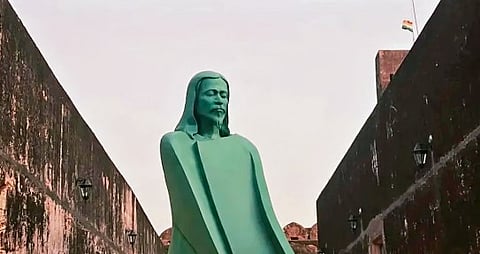
- LIFESTYLE
- FASHION
- FOOD
- ENTERTAINMENT
- EVENTS
- CULTURE
- VIDEOS
- WEB STORIES
- GALLERIES
- GADGETS
- CAR & BIKE
- SOCIETY
- TRAVEL
- NORTH EAST
- INDULGE CONNECT

Imagine a contemporary work of art that is deeply layered and concept-laden. Now, place it in an 11th-century fort in Jaipur, Rajasthan. Juxtaposing a heritage space that has stood for over a thousand years with a highly contemporary object, almost merging history with the present and future, makes it unique. Founded by The Saat Saath Arts Foundation, the fifth edition of The Sculpture Park was recently launched in collaboration with the Jaipur Centre for Art (JCA) at the Jaigarh Fort. Curator Peter Nagy says, “I looked for works that had a relationship with the decorative arts and would create a dialogue with the wall paintings.”
And the participating artists were more than happy. Subodh Gupta says, “While many people consider the white cube gallery space to be the ideal setting for displaying art, I find that unconventional spaces challenge my work and create a completely different atmosphere.” With his sculpture titled Kingdom of Earth, Gupta explores the idea of found objects, albeit from very different places and times. Rendered in stainless steel is a single column—part of the base from an ancient Greek temple (circa 6th-4th Century BC). Grafted to the side of the column is the bone of a dinosaur (the majority of dinosaurs were living during the Mesozoic Era, roughly 252 to 66 million years ago) that has been replicated in fibreglass. By bringing together these two objects, one man-made and the other organic, Gupta creates a contemporary artwork that confounds our understandings of both the passage of time and the recordings of history.
Payal Jain feels that bringing works outside the confines of the white cube carries profound significance. Her work titled Soul of a Woman commemorates her three decades of fashion. There is an experiment with abstract language, limited to only a few materials like cotton and repurposed yarn, and a single colour, ivory. The pieces on display have the human body as their starting point and go on to explore and exploit the qualities of the materials, abandoning functionality completely and venturing into the territory of fibre art. “When I first conceived this body of work, I wasn’t imagining it within any enclosed gallery space,” she says.
Noelle Kadar, co-founder of JCA,feels that at its core, the goal of The Sculpture Park is to seamlessly integrate contemporary art into Jaipur’s cultural and visual landscape. Over time, the hope is that the park fosters a growing appreciation for contemporary artistic practices, encouraging visitors to see Jaipur as a thriving centre for creative expression. Padmanabh Singh of Jaipur explains, “Jaipur has always been a centre for culture. It’s great to see this tradition being continued by contemporary arts initiatives, it adds so much diversity and depth.”
Ultimately, the vision for The Sculpture Park has been to democratise art. “Unfortunately, there is very little awareness about art, particularly contemporary art, among the public in India. Establishing the first sculpture park in India was therefore aimed at making people encounter art,” says Aparajita Jain, founder of The Saat Saath Art Foundation. It has set the ball rolling for further engagement.
Story by Rahul Kumar